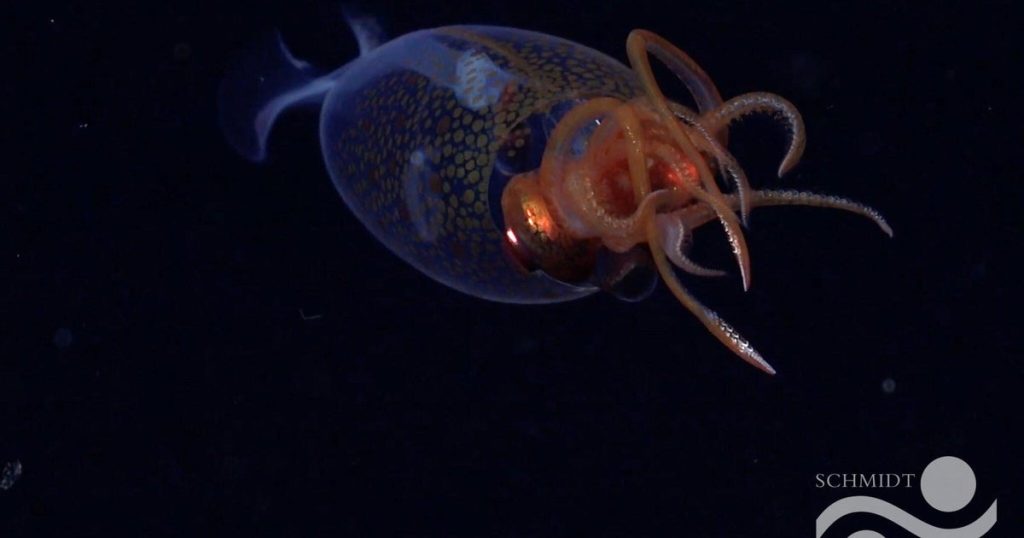In a remarkable discovery, a colossal squid was filmed and photographed in its natural habitat for the first time in a century. This significant event occurred during a research expedition in the South Atlantic Ocean, highlighting the elusive nature of this deep-sea giant. According to the Schmidt Ocean Institute, which led the expedition, this footage provides crucial insights into the life of the colossal squid and its environment.
| Article Subheadings |
|---|
| 1) Historic Footage Captured |
| 2) Details of the Colossal Squid Encounter |
| 3) Insights from Marine Researchers |
| 4) The Biology of Colossal Squids |
| 5) Continuing the Exploration of the Ocean’s Depths |
Historic Footage Captured
For the first time since the colossal squid was scientifically identified, footage capturing this mysterious creature in its natural habitat has been obtained. On March 9, crew members aboard the Schmidt Ocean Institute’s research vessel recorded the squid approximately 2,000 feet beneath the surface of the South Atlantic Ocean. This unprecedented sighting took place near the South Sandwich Islands, an isolated archipelago situated between South America and Antarctica, marking a major milestone in marine research. The colossal squid has been a subject of fascination and speculation since its discovery, and obtaining this footage represents a significant achievement for scientists studying deep-sea life.
Details of the Colossal Squid Encounter
The encounter was facilitated through the use of a remotely operated vehicle (ROV), a sophisticated tool that allows researchers to explore and record deep-sea environments without manned intervention. During the 35-day research voyage, the expedition focused on identifying new marine species in the region, which is known for its rich biodiversity and unique ecosystems. Even more intriguing, the squid filmed was classified as a juvenile, measuring about 11 feet long, far smaller than the enormous adults that can reach lengths of up to 43 feet and weigh over 1,100 pounds. This sighting adds a new layer to our understanding of this fascinating creature and its habitat.
Insights from Marine Researchers
Following the expedition, Kat Bolstad, a professor and researcher at the Auckland University of Technology in New Zealand, expressed excitement regarding the discovery. The crew consulted with Bolstad to verify the squid footage. “It’s exciting to see the first in situ footage of a juvenile colossal and humbling to think that they have no idea that humans exist,” Bolstad stated. This perspective highlights not only the amazement surrounding the discovery but also the ongoing mystery of the colossal squid’s existence in the vast ocean depths. The expedition also represents a win for marine conservationists, providing vital data on the behavior and ecology of lesser-known marine species.
The Biology of Colossal Squids
Colossal squids belong to the “glass squid” family, a designation referencing their remarkable transparent bodies during their juvenile stage. This unique physical trait, however, transitions to a more opaque appearance as they mature. Despite extensive studies, many aspects of the life cycle of the colossal squid remain shrouded in mystery. Observations made by fishermen indicate that the transition from juvenile to adult is marked by these physiological changes, reflecting a deeper understanding that is still being sought in the scientific community. Given their elusive nature and the challenges of studying them in their natural environment, researchers are continually working to uncover more about their behavior and habitat.
Continuing the Exploration of the Ocean’s Depths
The Schmidt Ocean Institute’s exploration efforts have thus far led to multiple sightings of marine life, including four different species of squid. Executive Director Jyotika Virmani described these encounters as “unforgettable moments,” adding that they serve as reminders of the ocean’s untold mysteries. With vast areas of the ocean still uncharted and unexplored, each research trip enhances our knowledge and raises crucial questions about the survival of various marine species – particularly in the face of climate change and human activity. The ongoing investigations and discoveries underscore the importance of marine research and conservation, aiming to protect these unique ecosystems for future generations.
| No. | Key Points |
|---|---|
| 1 | A colossal squid was filmed in its natural habitat for the first time in history. |
| 2 | The sighting occurred approximately 2,000 feet below the South Atlantic Ocean. |
| 3 | The captured squid was identified as a juvenile, measuring about 11 feet long. |
| 4 | Experts involved in the research noted the importance of such findings for marine biology. |
| 5 | This discovery has opened up new avenues for future research into deep-sea ecosystems. |
Summary
The recent discovery of a colossal squid captured on film marks a significant milestone in marine research, providing unprecedented insights into one of the ocean’s most enigmatic creatures. As researchers continue to explore the depths of the sea, the monumental endeavor not only reveals the complexities of marine life but also emphasizes the need for ongoing investigation and conservation efforts to safeguard our oceans. The Schmidt Ocean Institute’s efforts exemplify the excitement of scientific exploration and the critical importance of understanding the unknown.
Frequently Asked Questions
Question: What is a colossal squid?
A colossal squid is one of the largest squid species in the world, known for its immense size, with adults reaching lengths of up to 43 feet and weighing over 1,100 pounds.
Question: Where was the colossal squid filmed?
The colossal squid was filmed approximately 2,000 feet beneath the surface of the South Atlantic Ocean, near the South Sandwich Islands.
Question: Why is the sighting of a colossal squid significant?
This sighting is significant as it marks the first time a colossal squid has been filmed in its natural habitat, providing scientists with valuable data to study the species and its environment.


